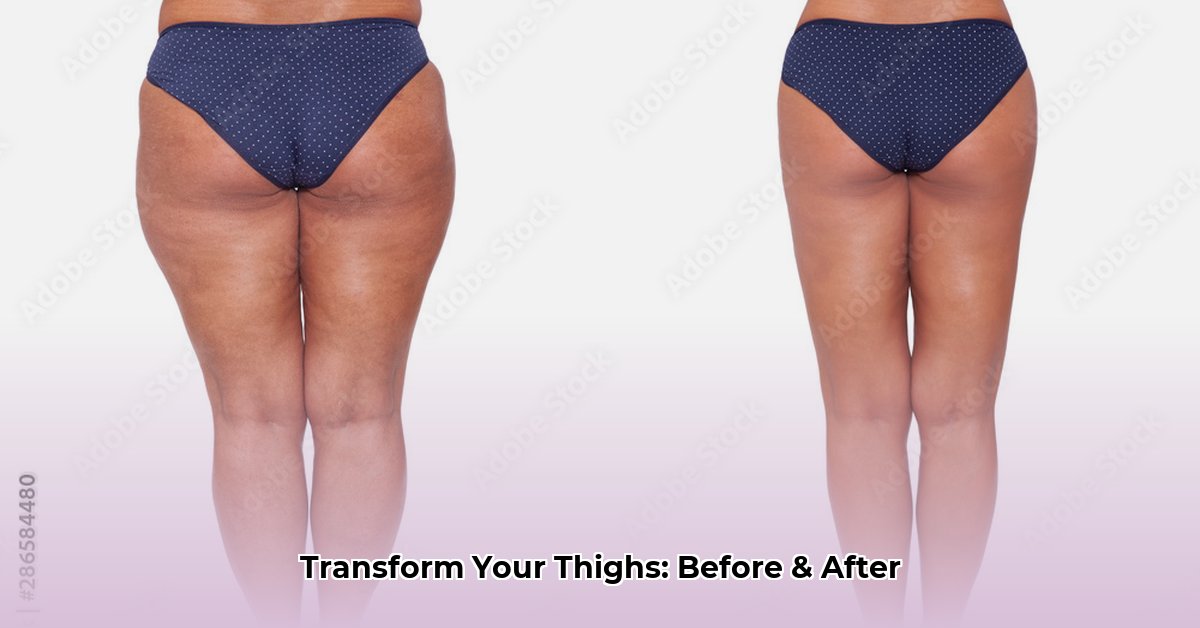
Weight Loss Thighs Before & After: Your Transformation Journey
Achieving significant weight loss is a monumental accomplishment, a testament to dedication and hard work. But sometimes, even after shedding those pounds, stubborn pockets of excess skin and fat remain, particularly on the thighs. This can leave you feeling as though your physical transformation isn't quite complete. A thigh lift, also known as a thighplasty, might be the solution you've been seeking. This comprehensive guide explores this procedure, empowering you to make an informed decision about whether it aligns with your goals.
What is a Thigh Lift? Understanding the Procedure
Imagine your thighs as a canvas. A thigh lift acts as a surgical "re-drape," removing excess skin and fat to reveal a smoother, more contoured silhouette beneath. It's a procedure designed to refine the appearance of your thighs, harmonizing them with your new, slimmer physique.
Two main types exist: the mini thigh lift, focusing on the inner or outer thigh, and the full thigh lift, addressing the entire thigh area for a more comprehensive result. The optimal approach depends heavily on individual needs and the surgeon's assessment. Incision techniques vary, strategically placed to minimize visible scarring and achieve the most natural and aesthetically pleasing outcome.
Am I a Good Candidate? Assessing Your Suitability
Before embarking on this journey, it's crucial to determine if a thigh lift is the right choice for you. Several key factors influence candidacy:
- Weight Stability: Have you maintained a stable weight for a considerable period? Significant fluctuations post-surgery can compromise results.
- Excess Skin: Is there noticeable sagging skin on your thighs unresponsive to diet and exercise?
- Overall Health: Good overall health is essential for a safe procedure and optimal recovery. Existing health conditions may impact suitability.
- Realistic Expectations: Remember, the goal is to refine your thigh appearance, not to create a dramatically different body shape.
The Thigh Lift Procedure: A Step-by-Step Overview
The process begins with a thorough consultation to discuss your goals and assess suitability. The surgery itself typically involves these steps:
- Anesthesia: General or local anesthesia is used to ensure patient comfort.
- Incisions: Incisions are strategically placed to minimize scarring, often within natural skin creases.
- Tissue Resection: Excess skin and fat are carefully removed.
- Tissue Redraping: The remaining skin is repositioned and secured using sutures.
- Closure: Incisions are closed.
- Bandaging: The surgical site is bandaged to protect and support healing.
The procedure's duration varies, generally lasting several hours depending on its complexity.
Recovery and Aftercare: The Healing Journey
Recovery involves a period of healing and adjustment. You can anticipate:
- Discomfort: Some pain and discomfort are typical, managed with prescribed medication.
- Swelling and Bruising: These are common and gradually subside over several weeks.
- Limited Mobility: Initial mobility restrictions are typical, gradually easing with time.
- Compression Garments: These may be worn to minimize scarring and support healing.
Your surgeon will provide detailed post-operative instructions, including dressing changes, follow-up appointments, and activity limitations. Adhering to these instructions is paramount for optimal healing and reducing complication risk. Complete healing generally takes several months, with significant improvement often visible within 3 months.
Before & After Photo Gallery: Real-Life Transformations
(This section will feature a diverse range of before-and-after photographs. Each image will include a brief, anonymized caption indicating the type of thigh lift, approximate weight loss, and age range.)
Potential Risks and Complications: A Realistic Perspective
While rare, potential risks and complications should be understood:
- Infection: A risk inherent to any surgical procedure. Prompt treatment is crucial.
- Hematoma (Blood Clots): Blood clots can form beneath the skin, requiring attention.
- Seroma (Fluid Collection): Fluid accumulation may necessitate drainage.
- Poor Scarring: Minimizing scarring is a priority, but some scarring is possible.
- Nerve Damage: Temporary or permanent numbness or altered sensation may occur.
- Unsatisfactory Results: While uncommon, results may not always meet individual expectations.
- Deep Vein Thrombosis (DVT): A serious, though rare, complication.
Your surgeon will discuss these risks in detail during your consultation.
The Cost Factor: Navigating Financing Options
The cost of a thigh lift varies based on several factors, including surgeon's fees, anesthesia, facility fees, and post-operative care. Openly discussing total costs and exploring potential financing options during your consultation is recommended. Many surgeons offer payment plans to make the procedure financially accessible.
Finding the Right Surgeon: Your Key to Success
Selecting a qualified and experienced surgeon is crucial. Prioritize board-certified plastic surgeons with extensive experience in thigh lifts. Thoroughly research potential surgeons, reviewing their credentials, experience, and approach to patient care. Examining before-and-after galleries and reading online testimonials can provide valuable insights.
Real Patient Testimonials: Hearing From Others
(This section will include short, anonymized testimonials from previous patients, focusing on their experiences and results.)
Addressing Your Concerns: Realistic Expectations
While a thigh lift can significantly refine your thigh appearance, results vary individually. Factors such as your body type, the amount of excess skin, your healing process, and the surgeon's skill all influence the final outcome. This procedure complements your weight loss journey, not replacing the importance of a healthy lifestyle. Maintaining a balanced diet and regular exercise after your surgery is essential for long-term results.
Pros and Cons: Weighing the Options
| Pros | Cons |
|---|---|
| Improved thigh contour and definition | Surgical risks (infection, bleeding, scarring) |
| Increased confidence and self-esteem | Recovery time and potential discomfort |
| Removal of excess skin and fat | Cost and potential for financing limitations |
| Long-lasting results with proper care | Possibility of unsatisfactory outcomes (even with skilled surgeons) |
| Enhanced body image | Potential for asymmetry or uneven results |
Remember, this information is for educational purposes only and should not replace a consultation with a board-certified plastic surgeon. They will provide a personalized assessment and guide you towards the best decision for your individual needs and circumstances.